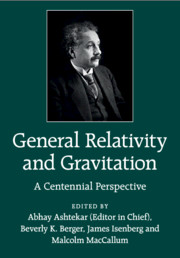Book contents
- Frontmatter
- Contents
- Preface
- List of contributors
- List of figures
- List of tables
- Part One Einstein's Triumph
- Part Two New Window on the Universe: Gravitational Waves
- Part Three Gravity is Geometry, after all
- Part Four Beyond Einstein
- 10 Quantum Fields in Curved Spacetime
- 11 From General Relativity to Quantum Gravity
- 12 Quantum Gravity via Supersymmetry and Holography
- Index
- References
10 - Quantum Fields in Curved Spacetime
from Part Four - Beyond Einstein
Published online by Cambridge University Press: 05 June 2015
- Frontmatter
- Contents
- Preface
- List of contributors
- List of figures
- List of tables
- Part One Einstein's Triumph
- Part Two New Window on the Universe: Gravitational Waves
- Part Three Gravity is Geometry, after all
- Part Four Beyond Einstein
- 10 Quantum Fields in Curved Spacetime
- 11 From General Relativity to Quantum Gravity
- 12 Quantum Gravity via Supersymmetry and Holography
- Index
- References
Summary
The nature of quantum field theory in curved spacetime
Quantum field theory in curved spacetime (QFTCS) is the theory of quantum fields propagating in a background, classical, curved spacetime (M, g). On account of its classical treatment of the metric, QFTCS cannot be a fundamental theory of nature. However, QFTCS is expected to provide an accurate description of quantum phenomena in a regime where the effects of curved spacetime may be significant, but effects of quantum gravity itself may be neglected. In particular, it is expected that QFTCS should be applicable to the description of quantum phenomena occurring in the early universe and near (and inside of) black holes – provided that one does not attempt to describe phenomena occurring so near to singularities that curvatures reach Planckian scales and the quantum nature of the spacetime metric would have to be taken into account.
It should be possible to derive QFTCS by taking a suitable limit of a more fundamental theory wherein the spacetime metric is treated in accord with the principles of quantum theory. However, this has not been done – except in formal and/or heuristic ways – simply because no present quantum theory of gravity has been developed to the point where such a well defined limit can be taken in general situations. Rather, the framework of QFTCS that we shall describe in this review has been obtained by suitably merging basic principles of classical general relativity with the basic principles of quantum field theory in Minkowski spacetime. As we shall explain further below, the basic principles of classical general relativity are relatively easy to identify and adhere to, but it is far less clear what to identify as the “basic principles” of quantum field theory in Minkowski spacetime. Indeed, many of the concepts normally viewed as fundamental to quantum field theory in Minkowski spacetime, such as Poincaré invariance, do not even make sense in the context of curved spacetime, and therefore cannot be considered as “fundamental” from the viewpoint of QFTCS.
- Type
- Chapter
- Information
- General Relativity and GravitationA Centennial Perspective, pp. 513 - 552Publisher: Cambridge University PressPrint publication year: 2015
References
- 9
- Cited by

